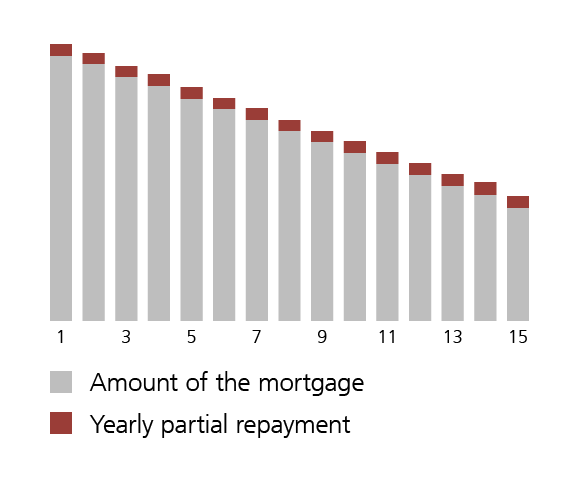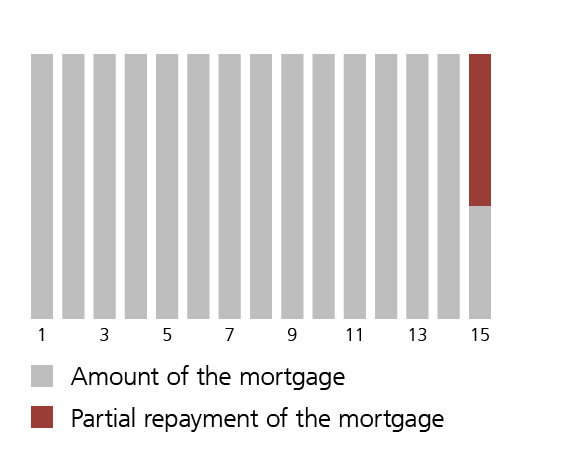We're here for you when you need us
Make an appointment for a non-binding consultation or call us directly if you have questions.
Debts have to be repaid. However, fully amortizing your mortgage is rarely the best solution. What you need to know.
Content:

Anyone who buys residential property usually takes out a mortgage, incurring a debt as a result. Repayments are often made in installments. In technical jargon, this is called amortization. The only time when you are obliged to amortize a mortgage is for your second mortgage.
A mortgage can be amortized in two ways: directly or indirectly. Direct amortization involves regularly reducing the debt – usually each quarter – by a fixed amount. This reduces the debt and the interest burden.
With indirect amortization, the debt remains in place. As a homeowner, you pay the amortization amount into a pillar 3a account, for example, which is pledged to the bank as collateral. At the latest on retirement, the capital is paid out and the sum is used to repay the mortgage.
Amortization is not to be confused with interest payments – the amortization amounts must be paid on top of the interest.
When you buy a property, you must provide equity corresponding to at least 20% of the property value. The bank will finance a maximum of 80%, split between two mortgages:
In contrast to the first mortgage, there is an obligation to amortize the second mortgage. You must amortize this mortgage within 15 years or by the time you reach retirement age – whichever comes first.
Does the first mortgage have to be amortized?
No, the law does not stipulate that the first mortgage has to be amortized. In principle, you can leave it in place for as long as you like. The question is, however, whether it is worth repaying the first mortgage or not. The answer depends on your personal circumstances.
Try and answer the following questions:
Contact a UBS expert, who will help you to make the right choice to suit your circumstances.
With direct amortization, the debt is regularly reduced directly by a fixed amount, usually on a quarterly basis. This reduces the debt, and hence also the interest burden.
The mortgage interest can be deducted from tax. As your mortgage decreases due to the regular amortization payments, you will pay less interest, but you will also be able to claim fewer tax deductions.
How is direct amortization calculated?
The mortgage amortization tranche is easy to calculate: To find the amount of the annual tranche, simply divide the amount of your second mortgage by 15 years. If amortization takes place quarterly, the annual tranche should then be divided by four.
To give a specific example, imagine that you have a second mortgage for 150,000 Swiss francs. You will have to repay 10,000 Swiss francs per year over a term of 15 years, or 2,500 Swiss francs per quarter.
How much will my mortgage cost?
With the mortgage calculator, you can easily and quickly find out whether you can afford your dream property.
With indirect amortization, the same amount is repaid each quarter or year, but the tranches are not paid directly to the bank. Instead, you make the payments into a retirement savings solution that you have pledged to the bank as security.
Indirect amortization usually takes place via pillar 3a. Indirect amortization allows you to build up retirement assets whilst saving taxes, as pension contributions can be listed as deductions on your tax return. The capital will be paid out on retirement at the latest. The mortgage will then be reduced by the retirement capital - where necessary.
Direct and indirect amortization


A comparison between direct and indirect amortization
Indirect amortization is often more financially advantageous than direct amortization. Whether this applies to you depends on the interest rates and on your personal tax situation.
The calculation example shows the differences between direct and indirect amortization.
Expense | Expense | Direct amortization | Direct amortization | Indirect amortization | Indirect amortization |
|---|---|---|---|---|---|
Expense | Amortized amount | Direct amortization | 200,000 | Indirect amortization | 200,000 |
Expense | Mortgage interest | Direct amortization | 48,000 | Indirect amortization | 96,000 |
Expense | Tax savings through deduction of debit interest | Direct amortization | –15,900 | Indirect amortization | –31,700 |
Expense | Interest credited to pillar 3a | Direct amortization |
| Indirect amortization | –700 |
Expense | Tax savings by deducting debt interest on pillar 3a contributions | Direct amortization |
| Indirect amortization | –66,000 |
Expense | Pillar 3a capital withdrawal tax | Direct amortization |
| Indirect amortization | 12,000 |
Expense | Total costs | Direct amortization | 232,100 | Indirect amortization | 209,600 |
Expense | Advantage of indirect amortization | Direct amortization |
| Indirect amortization | 22,500 |
Pros and cons: should you amortize your first mortgage?
There is no universal answer as to whether the amortization of your first mortgage is worthwhile. To make the decision easier for you, we have compiled a list of pros and cons:
Pro
Contra
Overall, amortizing a mortgage can be seen as a long-term strategy to achieve financial freedom. By making consistent repayments, not only will the property eventually become your own, but the interest burden will also gradually decrease.
If you are thinking about amortizing your mortgage, you should carefully consider whether direct or indirect amortization is the best option for you. In general, you only need to fully repay the second mortgage. Indirect amortization takes place via a pillar 3a retirement savings solution. In most cases, you will be better off with this option thanks to the tax savings.
You should also talk to a UBS expert 10 to 15 years before you retire to find out which solution is most suitable for you. We will be happy to advise you and to help you with your amortization calculations.
Make an appointment for a non-binding consultation or call us directly if you have questions.
Disclaimer
